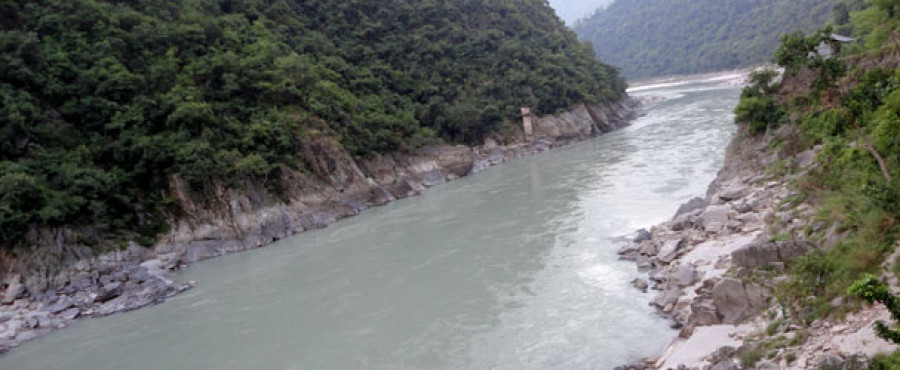National
Nepal proposes Team of Experts’ term extension to finalise Pancheshwar DPR
The fate of the bilateral project hangs in the balance as the two sides are yet to agree on issues of water and cost-sharing.
Prithivi Man Shrestha
Nepal has proposed a two-month tenure extension for the Team of Experts under the Governing Body of Pancheshwar Development Authority as its term ended in early January.
The secretary-level Team of Experts (ToE) was authorised to finalise the Detailed Project Report (DPR) of the multipurpose project. India’s state-owned Water and Power Consultancy Services (WAPCOS) Ltd had earlier prepared its revised draft.
The last meeting of the ToE held in October last year failed to finalise the DPR and its latest deadline extension ended on January 6 without finalising the report.
“It has been a month since we sent our proposal for extending the deadline of the Team of Experts to the Pancheshwar Development Authority on behalf of the Nepal government,” said Nabin Raj Singh, spokesperson for the Ministry of Energy and Water Resources. “We proposed the tenure extension as it is a competent body to finalise the DPR.”
As the Pancheshwar Development Authority is a bilateral mechanism, India should also make its own proposal on whether to extend its tenure, according to Nepali officials. “But the Indian side has not yet proposed an extension of its tenure,” an official at the authority told the Post.
Once both sides are ready, the body governing the authority could decide on whether to extend the panel’s term, the official said.
In early July last year, a meeting of the Pancheshwar board of directors extended the tenure of the expert team by six months till January 6 to enable the defunct body to conclude the DPR. Previously, its term had expired in March.
The mechanism [ToE] was revived after Nepal and India agreed to work towards finalising the DPR within three months when Prime Minister Pushpa Kamal Dahal visited New Delhi between late May and early June last year.
The two sides had accelerated the talks on finalising the DPR of the 6,480MW project. And, subsequently, the meeting of the governing body and the ToE was held last year. The first meeting of the ToE held in New Delhi in late July instructed WAPCOS to revise the DPR in line with the understanding reached in earlier meetings.
Another meeting held in Kathmandu in early October last year also failed to finalise the DPR as the two sides couldn’t reach any understanding on whether to consider the existing use of the Mahakali river water by India via the Lower Sharda barrage as consumptive use.
Nepal does not recognise the use of water by India via Lower Sharda Barrage as a component of the Mahakali Treaty. That is why Nepal argues that it should not be considered an existing consumptive use. But, India wants it to be included as an existing consumptive use because the neighbour is using the water of Mahakali, which is called Sharda in India.
India draws 7 of the 12 bcm (billion cubic metres) from the upper Sharda barrage built on the India-Nepal border for irrigation purposes in Uttar Pradesh. The remaining 5bcm comes from the lower Sharda barrage, which is 150km downstream on the Indian side.
Whether to consider it as existing consumptive use will have a direct bearing on the sharing of the cost of developing the project, as per the Mahakali Treaty signed by the two countries in 1996.
According to Article 3(3) of the 1996 Mahakali Treaty, the project’s cost will be borne by the parties in proportion to the benefits they stand to enjoy.
Article 3 further says that both parties agree that they have equal entitlement to the utilisation of water of the Mahakali river without prejudice to their respective existing consumptive uses of the river's water.
With India using more water from the river for irrigation purposes, the existing use of water by India cannot be counted for cost-sharing for project development.
Nepal has conceded more rights to India as per clause 3(B) of the Letter of Exchange of the Mahakali Treaty. As per this clause, the treaty “precludes the claim, in any form, by either party on the unutilised portion of the shares of the waters of the Mahakali river of that party without affecting the provision of the withdrawal of the respective shares of the waters of the Mahakali river by each party under this treaty.”
Non-inclusion of water by India from Lower Sharda Barrage as existing consumptive use can show India’s benefit higher and will lead the country to share more cost.
Nepali officials said it is not that the two sides had failed to agree on anything under the DPR.
“In fact, the majority of differences have already been bridged,” said an official at the energy ministry. “But the issue of water sharing and the cost to be borne by each side continue to be the stumbling block to the DPR’s conclusion.”
Nepali officials said that the two sides have more or less agreed to give the benefit from hydropower a weightage of around 70 percent, while keeping the share of irrigation and flood control benefit at around 30 percent.
They have also agreed to take equal benefits from hydropower and share the cost accordingly.
But Nepal wants to keep other benefits as low as possible to avoid bearing more cost. As per a Nepali calculation, Nepal’s benefit should not be more than five percent from irrigation and flood control while the southern neighbour proposed to keep Nepal’s benefit in the range of around 18 percent in the last meeting of the team of experts, officials at the energy ministry told the Post earlier.
As per the earlier DPR prepared by India's state-owned Water and Power Consultancy Services Ltd, the two sides will enjoy equal benefits in power but India will enjoy 65 percent benefit in irrigation and 82 percent benefit in flood control.
But Nepal, in particular, has not agreed to these recommendations as the benefits it stands to enjoy in the areas of irrigation and flood control could be close to nil.
According to the ministry official, Nepal could irrigate a maximum of 100,000 hectares of land following the completion of this project while India could irrigate as much as 3.5 million hectares.
Likewise, the dam to be built for the hydroelectric project will help regulate the water flow, minimising flood risks for India, a downstream country.
According to an official at the ministry, there has been an understanding to scale down the project’s size from 6,480 MW to below 5,000 MW.




 17.29°C Kathmandu
17.29°C Kathmandu















